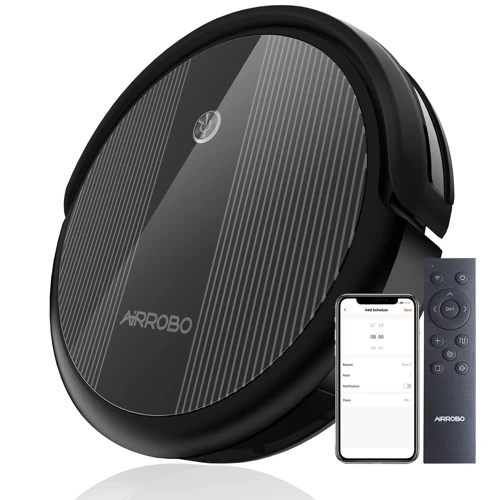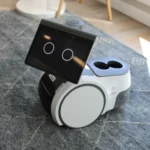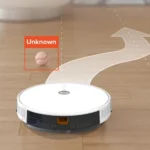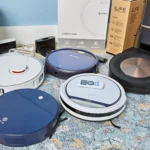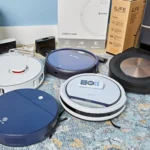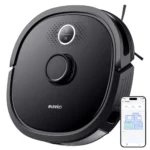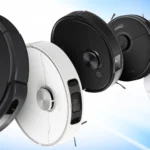Keeping our homes clean is crucial for maintaining a healthy life. But cleaning can be a time-consuming task, which is why many people opt for smart vacuum cleaners. Wi-Fi enabled smart vacuum cleaners have brought the next level of automation to the world of cleaning devices. With features such as mobile app controls, integration with smart home systems, improved mapping technology, and voice control options, these devices offer convenience and advanced cleaning performance. However, they also come with a few downsides such as high price points, connectivity issues, limited battery life, technical glitches, and security concerns. In this article, we will explore the pros and cons of Wi-Fi enabled smart vacuum cleaners in detail.
Pros of Wi-Fi Enabled Smart Vacuum Cleaners

In today’s fast-paced world, saving time and adding convenience in our daily routine is becoming increasingly important. With the invention of Wi-Fi enabled smart vacuum cleaners, cleaning our homes has become much easier and effortless. These cutting-edge devices have revolutionized the age-old, mundane task of vacuuming by offering a wide range of features and benefits. Let’s explore some compelling reasons why owning a Wi-Fi enabled smart vacuum cleaner could make your life easier and your home cleaner.
1. Convenient Control with Mobile App
One of the significant advantages of Wi-Fi enabled smart vacuum cleaners is the convenience of controlling them using a mobile app. With the mobile app, homeowners can command the vacuum cleaner to clean specific areas or the entire house with just a few taps on their smartphones. The app interface is usually user-friendly, making it easy for anyone to navigate the controls conveniently.
The app provides homeowners with valuable information and real-time updates about the cleaning progress, battery level, scheduled cleaning timing, and any error notifications. Users can also program their cleaning schedule into the app, and the vacuum cleaner will operate autonomously, freeing up more time for other essential activities.
For instance, if you are busy at work, you can use your smartphone to switch on the vacuum, and by the time you get home, your floors are clean and ready to use. The smart vacuum mobile app also allows users to monitor the cleaning process in real-time, adjusting any necessary settings to ensure optimal cleaning results.
Compared to traditional vacuum cleaners, which require a manual setup, Wi-Fi enabled smart vacuum cleaners are more convenient as you can set them up once and control them from anywhere, anytime.
However, sometimes homeowners may experience connectivity issues when their smart vacuum cleaner fails to connect to the home Wi-Fi network. In such cases, they might need to troubleshoot the device or check their network settings to get everything back in order. If this happens to you, check out our smart vacuum Wi-Fi troubleshooting guide to fix the problem.
If you’re interested in purchasing a Wi-Fi enabled smart vacuum cleaner, check out our list of the 10 best Wi-Fi smart vacuums in 2021. However, be prepared to pay a premium price for these high-tech devices as they tend to cost more than their non-smart counterparts. To learn more about the cost of owning a Wi-Fi enabled smart vacuum cleaner, click on our smart vacuum Wi-Fi cost guide.
The mobile app control feature of Wi-Fi enabled smart vacuum cleaners provides users with a new level of convenience, saves them time, and provides more flexibility in their cleaning schedule. Set up your device with ease by checking out our Wi-Fi smart vacuum app setup guide and also consider setting up a cleaning schedule using our smart vacuum app cleaning schedule guide. For homeowners with voice-controlled homes, don’t forget to check out our guide on how to connect your smart vacuum to Alexa or Google Assistant.
2. Seamless Integration with Smart Home Systems
One of the biggest advantages of Wi-Fi enabled smart vacuum cleaners is their seamless integration with smart home systems. With this feature, homeowners can control their vacuum cleaner with a simple voice command or through their mobile app.
Here are some of the benefits of seamless integration:
- The vacuum cleaner can be controlled through Alexa or Google Assistant, providing the convenience of hands-free cleaning. Users can ask Alexa or Google Assistant to start, stop or dock the vacuum cleaner with ease
- The integration with smart home systems offers the ability to customize cleaning schedules through the mobile app or voice command. Homeowners can set up cleaning schedules based on their preferences, such as daily, weekly or bi-weekly cleaning. This saves time and effort as the vacuum cleaner automatically starts cleaning according to the pre-set schedule
- With Wi-Fi enabled smart vacuum cleaners, users can connect to the device from anywhere as long as they have an internet connection. This eliminates the need for physical interaction with the device and allows users to monitor the cleaning process in real-time through their mobile app
It’s important to keep in mind that to utilize this feature, homeowners need to connect their smart vacuum cleaner to their Wi-Fi network. This may require some initial set up, but once it’s done, users can enjoy the added benefits of a fully integrated smart home cleaning system. If you’re interested in connecting your smart vacuum to a Wi-Fi network, consider reading our guide on Smart Vacuum Wi-Fi Setup for step-by-step instructions.
Despite the convenience, seamless integration with smart home systems comes at a cost. Homeowners should consider the price point of these devices before making a purchase. Additionally, users may encounter connectivity issues and network dependence that can hinder the smart home experience.
3. Improved Cleaning Performance with Mapping Technology
One of the most significant advantages of Wi-Fi enabled smart vacuum cleaners is their improved cleaning performance, made possible by mapping technology. Unlike traditional vacuums that just blindly move around a room, smart vacuums use mapping technology to scan and analyze the layout of the room, creating a detailed map of the floors and obstacles.
With this information, the robot vacuum can create an efficient cleaning path, making sure it doesn’t miss any spots or unnecessarily cover areas it has already cleaned. The mapping technology also enables it to sense and avoid obstacles such as furniture and walls, preventing any unwanted collisions or damages.
Additionally, some smart vacuums come equipped with advanced features such as object recognition, allowing them to identify and clean specific areas of the floor more thoroughly. With just the touch of a button on the app or using voice command with a compatible smart home system like Alexa or Google Assistant, the vacuum will clean every corner of the room.
Thanks to the mapping technology, users can also customize cleaning maps and schedules for each room, which can be done through an easy-to-use app. This allows users to specify specific areas or rooms to clean at certain times, such as when they are away from home or when they want to prioritize cleaning of a specific room.
Mapping technology guarantees improved cleaning performance and efficiency that is tailored to your preferences and needs, providing you with a cleaner and more comfortable home environment.
If you want to explore more on top quality Wi-Fi enabled smart vacuum cleaners or how to set them up via an app, we recommend checking out 10 Best Wi-Fi Smart Vacuum Cleaners in 2021 or How to Set Up Your Wi-Fi Smart Vacuum with its App. For more information on customizing your cleaning schedules using a smart vacuum app, you can check out How To Set Cleaning Schedule On A Smart Vacuum App. If you are interested in voice control features with Alexa or Google Assistant, Smart Vacuum with Alexa and Google Assistant: Voice Control Features might be helpful for you.
4. User-friendly Features such as Voice Control
Wi-Fi enabled smart vacuum cleaners come with a range of exciting features, and one of the most user-friendly features of these devices is voice control. With the integration of voice assistants like Alexa and Google Assistant, users can easily control their vacuum cleaners with simple voice commands.
The benefits of voice control in smart vacuums are:
- Convenience: Voice control allows you to operate the vacuum cleaner while doing other tasks. You can instruct the vacuum cleaner to start, stop or pause without having to stop whatever you are doing.
- Simplicity: With voice control, there is no need to fumble around for your phone or a remote control. Simply say the command, and the vacuum cleaner responds intuitively.
- Better accessibility: Voice-controlled smart vacuums offer a great solution for people with mobility issues, making it easier for them to operate the device without having to bend down or get up from their seats.
- Hands-free operation: With voice control, you no longer need to press buttons or navigate through complicated menus. This makes the whole process much more streamlined and simple.
- Customization: With some models of smart vacuums, users can even set customized voice commands that can be tailored according to their preferences. For instance, you may set a command to ask the vacuum to focus on a particular area or define a specific cleaning routine.
While voice control is highly convenient and easy to use, it is important to note that this feature may not work well in all situations. Noisy environments or incorrect pronunciations might cause errors in the device’s response. Nevertheless, voice control is still a great feature that makes a positive difference in terms of practicality and convenience.
5. Real-time Notifications and Alerts
One of the benefits of Wi-Fi enabled smart vacuum cleaners is the ability to receive real-time notifications and alerts. These features can be incredibly useful to homeowners who lead busy lives and want to keep their home clean without constantly monitoring their vacuum cleaner’s progress.
Real-time notifications allow users to be notified when their vacuum cleaner has finished cleaning a specific area, has run out of battery, or is experiencing an issue that requires assistance. This feature is especially convenient for homeowners who want to set their vacuum cleaner to clean their home while they’re away, so they can receive an update on their cleaning progress as soon as they return.
Alerts also help users stay informed about any potential problems with their smart vacuum cleaner. For example, if the dustbin is full or the filter needs to be changed, the vacuum cleaner will send an alert to the user’s smartphone or tablet. This will help them to take immediate action and ensure that their vacuum cleaner is running smoothly.
To further illustrate the benefits of real-time notifications and alerts with Wi-Fi enabled smart vacuum cleaners, we can use the following table:
| Real-time Notifications | Alerts |
|——————————–|———————————————|
| Know when cleaning is complete | Notify about problems like the dustbin full |
| Receive updates on cleaning | Alert users when filters need to be changed |
| Be notified of battery status | Monitor the vacuum cleaner’s progress |
The real-time notifications and alerts features with Wi-Fi enabled smart vacuum cleaners are incredibly useful for busy homeowners who want to keep their home clean but don’t have the time or energy to constantly monitor their vacuum cleaner.
Cons of Wi-Fi Enabled Smart Vacuum Cleaners
While Wi-Fi enabled smart vacuum cleaners offer many advantages, there are also some potential drawbacks that users should consider before making a purchase. These devices are not without their challenges, and it’s important to weigh the pros against the cons to determine if they are the right choice for your needs. In this section, we’ll explore some of the downsides of these high-tech cleaning machines, from their price points to concerns about privacy and security. So, let’s dive into the potential cons of using Wi-Fi enabled smart vacuum cleaners in your home.
1. Expensive Price Point
When it comes to purchasing a Wi-Fi enabled smart vacuum cleaner, one of the biggest concerns for many consumers is the price point. While traditional vacuum cleaners can be purchased for a relatively affordable price, smart vacuum cleaners tend to come with a higher price tag due to the advanced technology they offer.
Table 1: Price Comparison of Smart Vacuums
| Smart Vacuum Cleaner | Price Range |
|---|---|
| iRobot Roomba i7+ | $799-$999 |
| Shark IQ R101AE | $549-$599 |
| Eufy Robovac 11S | $219-$249 |
As seen in Table 1, the price range for smart vacuum cleaners can vary greatly depending on the brand and model. However, it is important to consider the potential cost savings in the long run. Smart vacuums typically require less manual labor and can help keep your home cleaner on a regular basis, which can lead to less wear and tear on flooring and furniture. Additionally, some models offer features such as self-emptying dustbins, which can save time and effort for the homeowner.
Another consideration is the added value of the advanced technology that smart vacuums offer. Mapping technology allows the vacuum cleaner to scan and clean your home more efficiently and effectively than a traditional vacuum cleaner. Voice control and mobile app integration add an extra layer of convenience for the homeowner. While the initial cost may be high, the added value may make it worth the investment for some consumers.
While the price point of Wi-Fi enabled smart vacuum cleaners may seem expensive initially, it is important to consider the potential cost savings and added value that the technology offers. It may be worth the investment for those who value convenience and efficiency in their cleaning routine.
2. Connectivity Issues and Network Dependence
One of the major concerns with Wi-Fi enabled smart vacuum cleaners is the potential for connectivity issues and their dependence on network stability. These devices rely on a strong and stable wireless internet connection in order to function properly. However, if the internet goes down, or there are any disturbances in the network signal, the device may either stop working altogether or experience a drop in functionality, which can be frustrating for users.
Additionally, some customers have reported issues with the connection between the app and the device. Bugs or glitches with the app or firmware updates can cause disconnection, making it impossible for the user to control the vacuum cleaner via their smartphone. Although these issues can often be resolved with a simple reboot or firmware update, they can still be a hassle for users.
Another potential issue with network dependence is the fact that these devices often require a lot of bandwidth to operate properly. This can be problematic if you have multiple devices connected to your home network, as it can slow down your internet speed and cause connectivity issues with other devices.
Despite these concerns, there are ways to mitigate connectivity issues and ensure that your Wi-Fi enabled smart vacuum cleaner is functioning at its best. Ensuring that your home Wi-Fi network is set up properly and has adequate bandwidth, and checking the app and firmware updates regularly for any bug fixes or improvements can reduce the likelihood of connectivity issues. Additionally, some models may also have the ability to function without Wi-Fi, which can be a good backup option in case of any network problems.
3. Limited Battery Life and Cleaning Time
One of the main concerns with Wi-Fi enabled smart vacuum cleaners is their limited battery life and cleaning time. As these vacuums rely on battery power, they are bound to run out of charge during the cleaning process, requiring them to return to their charging station for a recharge.
To give you a better idea of the battery life and cleaning time of some of the leading Wi-Fi enabled smart vacuum cleaners, we’ve put together this table:
| Vacuum Cleaner | Battery Life | Cleaning Time |
|---|---|---|
| iRobot Roomba S9+ | 120 minutes | Up to 180 minutes |
| Shark IQ Robot Self-Empty XL | 90 minutes | Up to 120 minutes |
| Ecovacs Deebot Ozmo T8 AIVI | 110 minutes | Up to 200 minutes |
As you can see, while some models offer a longer battery life than others, none of them can clean continuously for an extended period. This means that if you have a large home or a lot of carpeting, you may need to divide the cleaning into several sessions, which may not be convenient for some users.
Additionally, strong suction power or running on carpeting can impact battery life. When the battery runs low, the vacuum may also struggle or fail to return to its charging station, causing frustration for the user.
Overall, while the limited battery life and cleaning time of Wi-Fi enabled smart vacuum cleaners may not be a deal-breaker for everyone, it’s important to consider if you have a larger home or schedule that does not allow for multiple cleaning sessions.
4. Technical Glitches and Maintenance Needs
When it comes to Wi-Fi enabled smart vacuum cleaners, technical glitches and maintenance needs can be hefty concerns that need to be taken into account before making a purchase decision. While these smart vacuums offer numerous cutting-edge features, they can still face technical issues that require troubleshooting and maintenance. Additionally, without the proper care and upkeep, these vacuum cleaners may not operate at maximum efficiency, leading to potential frustration and inconvenience.
Technical Glitches: One of the most significant drawbacks to Wi-Fi enabled smart vacuum cleaners is the potential for technical glitches. These glitches can arise from a variety of different sources, such as software bugs, network connectivity issues, or communication errors between the vacuum and its app. These glitches can lead to a poor cleaning experience, with the vacuum not functioning correctly, or even failing to operate altogether. To minimize the risk of technical glitches, it is essential to research the brand and model carefully before making a purchase, and to read reviews from other users to identify any recurring problems.
Maintenance Needs: Along with the risk of technical glitches, Wi-Fi enabled smart vacuum cleaners may also require significant maintenance needs to keep them working at their full potential. This includes regular cleaning and emptying of the vacuum’s dustbin, replacing parts such as filters and brushes, and performing firmware updates to ensure the vacuum’s software is up to date. Neglecting these maintenance needs can lead to reduced cleaning efficiency, shortened battery life, and potential damage to the vacuum itself.
To make things easier for users, many smart vacuum cleaners now come with companion apps that provide maintenance reminders and notifications when parts require replacement. However, it is still essential to stay vigilant and perform regular check-ups to ensure the vacuum runs optimally.
Wi-Fi enabled smart vacuum cleaners offer numerous benefits over traditional vacuum cleaners, but they also come with certain drawbacks, such as technical glitches and maintenance needs. By doing thorough research on the brand and model, staying on top of maintenance requirements, and troubleshooting issues promptly, users can help ensure a positive and seamless experience with their smart vacuum cleaner.
| Pros | Cons |
|---|---|
| Convenient control with mobile app | Expensive price point |
| Seamless integration with Smart Home systems | Connectivity issues and network dependence |
| Improved cleaning performance with mapping technology | Limited battery life and cleaning time |
| User-friendly features such as voice control | Technical glitches and maintenance needs |
| Real-time notifications and alerts | Security and privacy concerns |
5. Security and Privacy Concerns
While Wi-Fi enabled smart vacuum cleaners are convenient and assist us in accomplishing daily cleaning tasks, there are certain risks associated with their use. One of the most significant concerns relates to security and privacy.
Security concerns are a significant issue when using these appliances. Smart vacuums are connected to the internet, and if not adequately secured, could be hacked, which could lead to unauthorized access to the user’s home network. Cybercriminals could potentially gain access to any other smart devices connected to the same network, stealing sensitive information or personal data, and even using these appliances to launch further cyber-attacks. In this way, a smart vacuum cleaner can pose a serious risk to your privacy and security.
Another concern is privacy. Many smart vacuums feature in-built cameras and microphones to facilitate remote control of the device. Although these features add to the convenience of smart vacuums, they also raise privacy concerns. If cameras and microphones are not properly safeguarded, hackers could exploit these features to gain access to sensitive footage or live feed of a user’s home.
It is essential to note that not all smart vacuums pose the same level of risk. Some models have robust security features and privacy policies that ensure that the user’s data is protected. When purchasing a smart vacuum, it is imperative to conduct diligent research to determine the device’s security and privacy features. Users can also take steps to secure their network by using secure passwords and regularly updating firmware.
Below is a table summarizing some of the key security and privacy considerations when purchasing a smart vacuum:
| Security | Privacy |
| Ensure the smart vacuum has robust security features to prevent unauthorized access | Check whether the smart vacuum has any cameras or microphones and if there’s a way to turn them off |
| Use strong passwords for Wi-Fi networks and avoid using default passwords | Read the smart vacuum’s privacy policy to understand how data is collected, stored, and shared |
| Regularly update the firmware of the smart vacuum to protect it against known vulnerabilities | Consider using a VPN to add an extra layer of privacy when controlling the device remotely |
It is crucial to balance the benefits and potential risks when deciding whether to invest in a smart vacuum. By taking measures to ensure the device’s security and privacy, users can enjoy the convenience and performance benefits that these devices offer, while still keeping their personal information and sensitive data safe.
Conclusion
In conclusion, while Wi-Fi enabled smart vacuum cleaners offer numerous benefits, they also come with certain drawbacks that need to be taken into consideration before making a purchase. The convenience of remote control through mobile apps and seamless integration with smart home systems is a major advantage in today’s fast-paced world. These features allow users to control their smart vacuums from anywhere and at any time, making it easy to keep their homes clean and tidy.
Furthermore, the mapping technology incorporated in smart vacuums can significantly improve their cleaning performance, while user-friendly features such as voice control make them incredibly easy to use. Real-time notifications and alerts provided as cleaning progresses enable users to monitor the progress and receive instant updates.
On the other hand, these vacuums are relatively expensive, which may make them unaffordable for some. Additionally, connectivity issues may arise and the network dependence of these devices may make them vulnerable to instability. The limited battery life and cleaning time restrict their use, while technical glitches and maintenance needs may cause inconveniences. Finally, security and privacy concerns arise as these devices store data and connect to networks that can be hacked.
In summary, Wi-Fi enabled smart vacuum cleaners are a great technological innovation that can make cleaning more efficient and user-friendly but users need to weigh the pros and cons before making a purchase decision. While these devices can offer a lot of convenience and performance in cleaning, users need to consider factors like price, connectivity issues, battery life, maintenance and security. Therefore, it is vital to conduct thorough research before investing in a Wi-Fi enabled smart vacuum cleaner to make the best choice for one’s home cleaning needs.
Frequently Asked Questions
1. Can I control the smart vacuum cleaner from anywhere?
Yes, you can control the smart vacuum cleaner using a mobile app from anywhere as long as you have an internet connection.
2. Do I need a smart home system to use a Wi-Fi enabled smart vacuum cleaner?
No, you don’t need a smart home system to use a Wi-Fi enabled smart vacuum cleaner. However, a smart home system can enhance the overall user experience and provide seamless integration.
3. How does mapping technology improve cleaning performance?
Mapping technology allows the smart vacuum cleaner to create a map of your home, identifying the areas that need cleaning and avoiding obstacles. This leads to more efficient cleaning and better coverage of your home.
4. Can I use voice control to operate a Wi-Fi enabled smart vacuum cleaner?
Yes, many smart vacuum cleaners support voice control, making it easier to start, pause or stop the cleaning process using voice commands.
5. Are real-time notifications and alerts useful features?
Yes, real-time notifications and alerts can be highly useful as they keep you informed about the status of the cleaning process, battery life, and other important information, allowing you to take necessary actions as needed.
6. Why are Wi-Fi enabled smart vacuum cleaners more expensive than traditional vacuum cleaners?
Wi-Fi enabled smart vacuum cleaners are more expensive because they come with advanced features, such as mapping technology, voice control, and mobile app integration, that are not found in traditional vacuum cleaners.
7. Can connectivity issues affect the performance of a smart vacuum cleaner?
Yes, connectivity issues can affect the performance of a smart vacuum cleaner as it relies on a stable internet connection to function properly. Disruptions in the network can lead to problems with control and data transmission.
8. How long does the battery last on a smart vacuum cleaner?
The battery life of a smart vacuum cleaner can vary depending on the model and usage patterns. On average, most smart vacuum cleaners can run for about 1-2 hours on a single charge.
9. Are there any common technical glitches that can occur with smart vacuum cleaners?
Yes, common technical glitches that can occur with smart vacuum cleaners include problems with connectivity, mapping errors, and update issues. Regular maintenance and troubleshooting can help prevent these problems from occurring.
10. Should I be concerned about security and privacy issues with a Wi-Fi enabled smart vacuum cleaner?
Because smart vacuum cleaners are connected to the internet, there is a risk of security and privacy breaches. However, most models come with built-in security features such as encryption and password protection. It’s important to always use strong passwords and keep the firmware up-to-date to prevent these types of issues.
